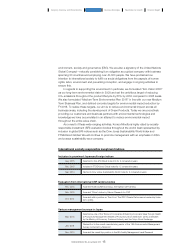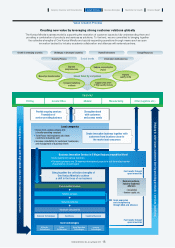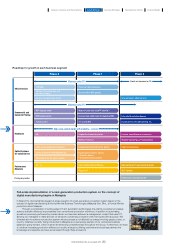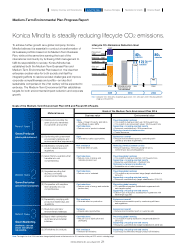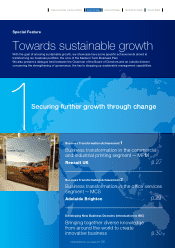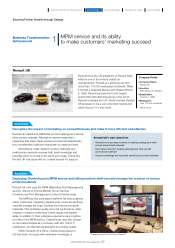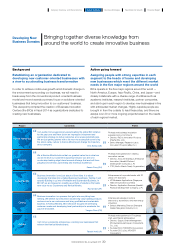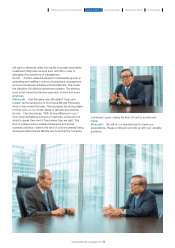Konica Minolta 2015 Annual Report Download - page 25
Download and view the complete annual report
Please find page 25 of the 2015 Konica Minolta annual report below. You can navigate through the pages in the report by either clicking on the pages listed below, or by using the keyword search tool below to find specific information within the annual report.
Regarding Group balance sheet management, essentially we
are pursuing streamlining and greater efficiency while
maintaining a number of important points. One point is
securing liquidity, or cash on hand. However, in the case of
the Konica Minolta Group, having everything in cash is not
required. We have therefore shifted towards an off-balance-
sheet approach, which involves counting credit lines from
financial institutions as cash on hand and decreasing the
assets balance on the balance sheet by that amount.
The second point is managing current assets and current
liabilities. Konica Minolta has five business segments and each
of these have significantly different accounts receivables-
trade, inventory scales, collection periods and so forth.
Therefore, the Group works to ensure optimal balance sheet
management for each business area utilizing various
measures such as checking the cash conversion cycle of
each business.
Furthermore, regarding investment and loan activities, we
have a policy of proactively using upfront investment
necessary for growth. However, we also streamline by
excluding items like equipment from balance sheets as much
as possible. Finally, in order to suppress financial leveraging,
taking management stability into consideration, our policy is
appropriate operations that hold it to approximately two-fold
from the aspect of intensifying growth investment.
Progress towards the Medium Term Business Plan of 10% ROE or higher (IFRS base)
* ROE = Profit attributable to owners of the company / (Share capital + Share premium + Retained earnings + Treasury shares
(average at start of fiscal year and end of fiscal year))
Q4.
Please explain the balance sheet management
policies such as assets turnover and financial
leverage.
A4. We implement detailed balance sheet management
to suit the characteristics of each business.
shares are currently owned by foreign investors. Adopting
IFRS, the ROE for fiscal 2014 was 8.7%, and our target for
the Medium Term Business Plan is to achieve a ROE of 10%
or more by fiscal 2016. However, we are now striving to
achieve this a year earlier, in fiscal 2015.
The calculation for ROE is as follows: ROE = profit ratio x
assets turnover x financial leverage. There are a number of
ways to increase ROE; however, the Konica Minolta Group is
placing greatest emphasis on increasing the profit ratio for the
year.
We have implemented various initiatives such as raising
employee awareness and revising assessment systems in
order to increase profit for the year. As one of the employee
key performance indicators (KPIs) or key goal indicators
(KGIs), the Konica Minolta Group places special importance
on contributing to operating profit. However, now that we
have adopted IFRS, profit such as non-operating profit and
extraordinary income and loss other than finance income and
loss are also incorporated. This has made it difficult to assess
performance and achievement of targets using operating
profit alone. Meanwhile, profit for the year is an important
indicator that has a direct impact on ROE. Accordingly, we
must raise employee awareness of corporate goals and
steadily increase profit for the year from now on. However, it is
difficult for employees in the field to determine what is required
in order to increase profit for the year. This is why we believe it
is necessary to establish KPIs and KGIs, which break things
down in more detail and provide all employees with a concrete
code of conduct.
TargetResult
8.7%
4.1%
1.01
2.09
10% or higher
5% or higher
1.0 or higher
2.0
Fiscal 2016Fiscal 2014
Themes/Measures
A shift in the focus of our business + Profitability
• Operating profit ratio – 8% or higher
• Non-operating income/Special loss improvement
Balance sheet management
• Sale of idle assets • Inventory reduction • Proactive shareholder return
Secure financial soundness
• Net debt/equity ratio: 0 • Credit ranking: Maintain A rating
ROE
Profitability
Profit ratio
Efficiency
Assets turnover
Soundness
Financial leverage
24
KONICA MINOLTA, INC. Annual Report 2015
Foundation for GrowthBusiness StrategiesGrowth StrategyCompany Overview and Characteristics Financial Report




